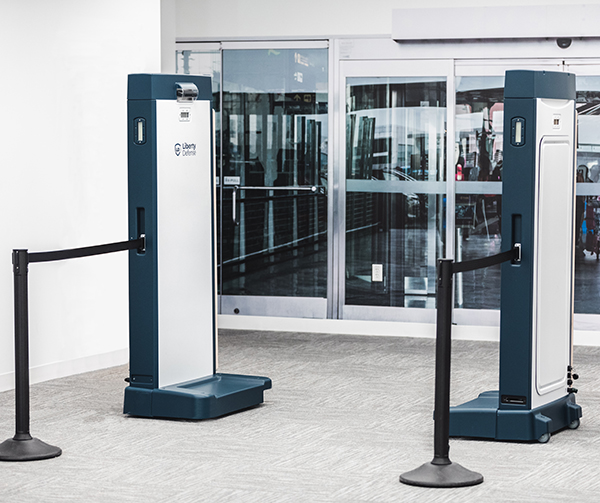Threat deterrence system developer Liberty Defense has unveiled plans to beta test its latest product on the campus of a US university.
Liberty Defense’s HEXWAVE screening portal is said to be capable of detecting metal and non-metal weapons, including ‘ghost guns,’ unserialized firearms that can be 3D printed or bought and assembled at home. Following on from HEXWAVE tests at major airports and sports venues across the United States, the firm now plans to deploy it as part of a beta trial at the University of Wisconsin-Madison.
“University campuses welcome thousands of students, staff, and visitors every single day, and play host to a wide array of educational, social, sporting, and other events on a regular basis,” said Bill Frain, CEO of Liberty Defense. “HEXWAVE has the potential to fill an important gap for campus security teams providing a heightened level of security and an improved student or guest experience.”
“It [HEXWAVE] offers flexible and portable deployment, with the capability to automatically detect both metal and non-metal threats, and other items of concern.”

What’s the big deal with ‘ghost guns?’
For the uninitiated, ‘ghost guns’ is a broad term used to describe unserialized firearms that can either be bought in the form of kits and put together at home, or 3D printed from scratch and assembled off the grid. The reason such firearms have caused so much controversy is that, unlike regular guns, they can be acquired by literally anyone, without them having to pass state-enforced background checks.
As a result, the potential for these guns to get into the wrong hands is significantly higher, and if they are used to carry out crimes, their unserialized nature means they’re difficult to tie to wrongdoers. In August 2021, for instance, it was revealed that two LA Sheriff’s Deputies planned to sue Polymer80 after being shot in the line of duty, by a firearm that was made from one of its untraceable ghost gun kits.
At time of writing, acquiring such ‘buy build shoot’ kits remains legal in the US, but President Joe Biden did announce a crackdown on ghost guns last year. Introduced in the form of ‘Final Rule 2021R-05F,’ these changes saw the US Bureau of Alcohol, Tobacco, Firearms and Explosives (ATF) mandate gun serialization, and alter how it defines a firearm to include unfinished frames and receivers.

However, despite pro-gun groups like the Gunowners of America labelling the reforms an attempt to “implement a radical gun control regime,” others questioned their impact on home-3D printed guns. Although the White House promoted the changes as a move to mark “ghost guns made from individual parts, kits or by 3D printers,” it also admitted they were designed to target “licensed firearm dealers.”
As a result, Youtuber Sean Aranda (aka 3D Print General) said last year that the reforms “do not affect 3D printed guns whatsoever.” While “not thrilled” that 3D printing was still being used to frame the discussion around ghost guns, Michael Weinberg, Executive Director of the NYU School of Law, also highlighted how the changes treat privately-made firearms the same, regardless of how they’re made. In fact, with this in mind, he saw the move as “a win for the 3D printing community.”
Given the widespread sensationalization of 3D printed guns in the media, it could be said that Weinberg had a point. In one example of this, which took place in October 2019, several media outlets reported that the gunman responsible for a synagogue attack in Germany was wielding a 3D printed weapon. However, it was later revealed that the firearm only featured non-critical additive manufactured parts.

Liberty Defense’s HEXWAVE trial
In essence, the HEXWAVE is a walkthrough screening portal designed to automatically detects hidden weapons and other potential threats. According to Liberty Defense, this includes “both metal and non-metal items such as 3D printed ghost guns,” as well as improvised liquid, powder, or plastic explosives.
To highlight such dangerous items, the system uses millimeter-wave, video-rate 3D imaging, and AI technologies, in a way that provides security operators with a real-time, automatic ‘go/no-go decision.’ As an added bonus, the non-invasive portal doesn’t require those passing through to hand over phones, keys, or wallets, making it faster than other detectors, and seamless to integrate into existing setups.
Having effectively deployed HEXWAVE in beta tests at Toronto Pearson International Airport and Oriole Park at Camden Yards in Baltimore, Liberty Defense is now set to trial the product with the University of Wisconsin–Madison Police Department.
“We look forward to testing HEXWAVE to see how it could enhance our robust security operations, particularly for large-scale events,” said Kristen Roman, Associate Vice Chancellor and Chief of Police at UW-Madison. “As the first university to test the HEXWAVE system, we are proud to have the opportunity to experience this security technology to see how it could improve both the experience and safety at our facilities.”
To stay up to date with the latest 3D printing news, don’t forget to subscribe to the 3D Printing Industry newsletter or follow us on Twitter or liking our page on Facebook.
While you’re here, why not subscribe to our Youtube channel? featuring discussion, debriefs, video shorts and webinar replays.
Are you looking for a job in the additive manufacturing industry? Visit 3D Printing Jobs for a selection of roles in the industry.
Featured image shows the Liberty Defense HEXWAVE screening portal. Photo via Liberty Defense.



